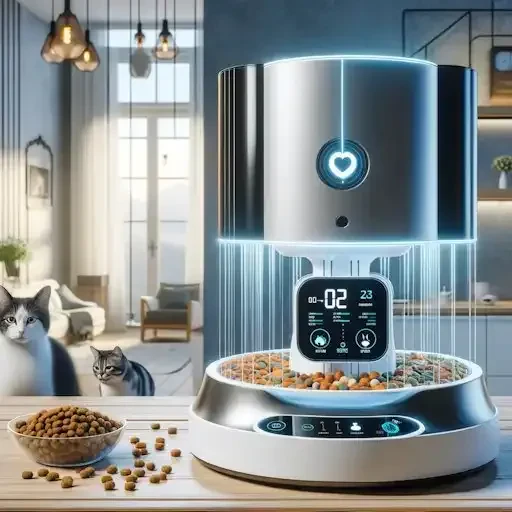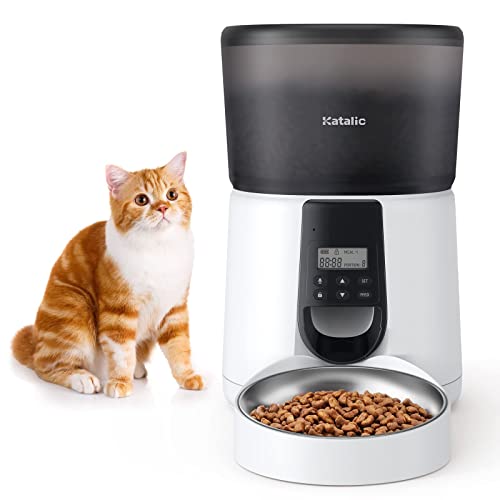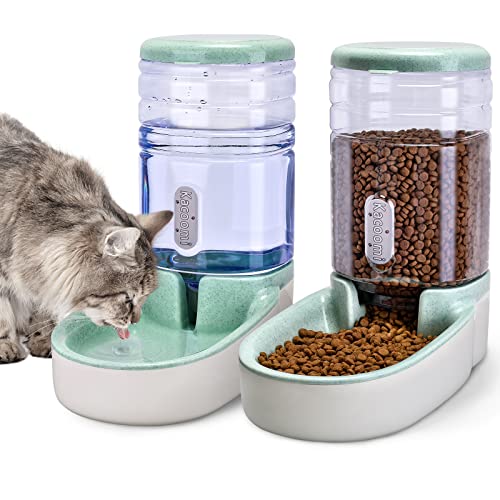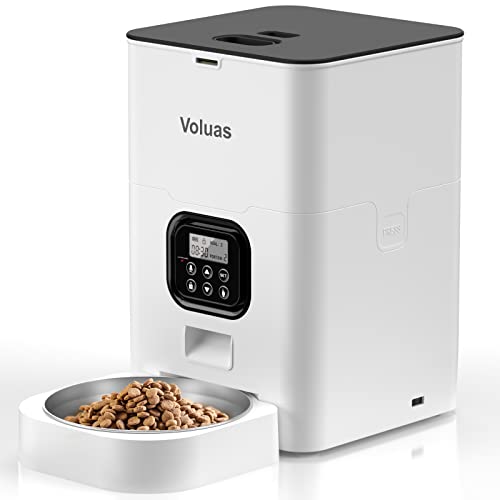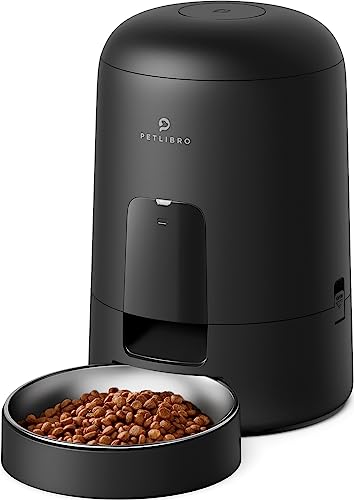Juggling work, family, and the endless demands of a hungry feline – does this scenario sound familiar? For many modern cat owners, the simple act of feeding our beloved companions can sometimes feel like just another item on an already overflowing to-do list. We strive to provide the best care, but busy schedules, varying routines, and the ever-present quest for optimal feline health can make traditional cat feeding methods feel, well, a little… antiquated. For generations, the standard food bowl has reigned supreme. However, in today's world of tailored pet care, we are beginning to recognize the limitations of this one-size-fits-all approach. Traditional bowls often fall short when it comes to precise portion control, frequently contributing to the growing concern of feline obesity and its associated health problems. For owners with demanding work lives or unpredictable schedules, relying solely on standard bowls can be inconvenient, leading to missed meals or rushed returns home just to replenish food. Furthermore, basic bowls offer no tailored solutions for cats with specific dietary needs, health conditions, or those living in multi-cat households where food competition can become a significant issue. Enter a new era of feline feeding: innovative cat feeders. Driven by the desire for convenience, precision, and most importantly, improved feline health, automated and health-focused feeders are rapidly transforming how we nourish our cats. These aren't just gadgets; they are thoughtful solutions, leveraging technology and clever design to address the challenges of modern cat feeding head-on. They offer a level of control and customization previously unimaginable, promising to revolutionize your cat's mealtimes, promote their well-being, and, perhaps surprisingly, simplify your life in the process. This article will embark on an exploration of this exciting world of innovative cat feeders, focusing on the myriad of automated and health-centric options that are available today, and guiding you towards finding the perfect feeding solution for your unique feline friend.
The realm of automated feeders opens up a world of convenience and unparalleled control over your cat's feeding schedule. At the forefront of automation are timed feeders, designed to dispense food with remarkable precision at pre-programmed intervals. These clever devices operate through various mechanisms, often employing a rotating carousel or a timed dispenser that opens a compartment at set times. Programmable schedules allow you to customize meal times to the minute, ensuring consistency even when your own schedule is disrupted. Many timed feeders also incorporate portion control features, allowing you to set not just when your cat eats, but how much they eat at each scheduled meal. The benefits for busy cat owners are immediately apparent. Timed feeders eliminate the worry of missed meals when you're working late, traveling for short periods, or simply unable to be home at specific feeding times. They offer a level of control over your cat's daily routine, managing meal times consistently and effectively. For many, a significant advantage is the prevention of early morning wake-up calls prompted by a hungry cat. With a timed feeder, breakfast is served automatically, allowing you to enjoy a few extra precious moments of sleep. The advantages extend beyond owner convenience to the cats themselves. Predictable meal times, delivered consistently by an automated feeder, can significantly reduce anxiety in cats who are prone to food-related stress. Regulated feeding patterns, established by timed dispensers, can promote better digestion and prevent erratic eating habits. And for cats who tend to be persistent food beggars, a timed feeder removes the association between their meowing and immediate food delivery, helping to break the begging cycle. Within the category of timed feeders, there's a spectrum of options to choose from. Basic timer models are simple and affordable, offering basic timed dispensing. Digital programmable feeders offer more advanced customization, with digital displays and the ability to set multiple meal times and portion sizes. Feeders with multiple compartments allow you to provide several smaller meals throughout the day, mimicking a more natural grazing feeding pattern. When selecting a timed feeder, certain features warrant careful consideration. Timer accuracy is paramount for consistent meal delivery. Portion size control, if important for your cat's diet, should be precise and reliable. Battery backup is a valuable feature, ensuring scheduled feedings continue even during power outages. Ease of cleaning and refilling is essential for hygiene and convenience. Material quality and durability are important for longevity and pet-proofing, ensuring your cat cannot tamper with the feeder to access extra food.
Portion control feeders take the concept of precise feeding a step further, specifically designed to combat overeating and feline obesity. These feeders operate by dispensing pre-set portions of food, ensuring your cat receives the correct amount at each meal. Often, portion control is integrated with timers for scheduled feeding, or sometimes they utilize weight sensors to dispense food based on pre-determined weight targets. For owners, portion control feeders offer a powerful tool for weight management in their cats. They simplify the process of preventing overfeeding, a major contributor to feline obesity. Tracking food intake becomes significantly easier, as you know exactly how much food is dispensed at each meal. Portion control feeders are particularly beneficial when implementing a weight loss plan for an overweight cat, allowing for precise and controlled calorie reduction. For cats, portion control feeders contribute to maintaining a healthy weight, actively preventing obesity and its associated health risks, such as diabetes, arthritis, and heart disease. Regulated food intake promotes a healthier metabolism and overall well-being. The types of portion control feeders vary in their precision and features. Gravity feeders, while sometimes marketed as portion control, are generally less precise. They rely on gravity to dispense food as the bowl empties, but portion sizes can be inconsistent. Electronic portion control feeders offer much greater accuracy, using mechanisms to dispense pre-measured amounts of kibble. These are typically more reliable for truly controlled portions. Some advanced feeders are even linked to smartphone apps, allowing for remote monitoring and adjustment of portion sizes. When choosing a portion control feeder, accuracy of portion control is the most critical feature. Ensure the feeder dispenses consistent and reliably measured portions. Consider the range of portion sizes offered, ensuring it can accommodate your cat's dietary needs, whether for weight maintenance or weight loss. Ease of programming and adjusting portions is important for user-friendliness. Durability is essential, as is suitability for different food types, particularly considering kibble size, as some feeders may struggle with very small or very large kibble.
For households with multiple cats, feeding time can often become a scene of chaos and competition, particularly when cats have different dietary needs. Microchip and RFID feeders offer a revolutionary solution for targeted feeding in multi-cat homes. These feeders utilize technology to recognize each cat individually, ensuring that only the intended cat can access their designated food. They operate by reading a cat’s existing microchip or an RFID (Radio-Frequency Identification) collar tag. When a registered cat approaches the feeder, the mechanism unlocks, granting access to the food bowl. When the registered cat moves away, the feeder closes, preventing other cats (or even dogs!) from stealing food. For owners of multi-cat households, microchip and RFID feeders are game-changers. They guarantee that each cat receives their prescribed diet, which is particularly crucial when cats are on different prescription foods or have varying dietary requirements due to age, health, or weight. They effectively prevent food aggression and competition among cats, reducing stress and promoting a more harmonious feeding environment. They also provide a reliable way to manage weight in multi-cat settings, ensuring that each cat receives the correct portion for their individual needs. For cats, microchip and RFID feeders reduce the stress associated with food competition. They guarantee access to their own food bowl without being bullied or chased away by other cats. This targeted feeding ensures they receive the nutrition they need, preventing overeating for some cats and undereating for others in a multi-cat dynamic. When considering microchip or RFID feeders, microchip compatibility is paramount. Ensure the feeder is compatible with your cat's microchip type (common types are readily supported, but check specifications). The RFID tag option provides an alternative if microchip reading is inconsistent or preferred. Ease of programming and cat registration is important for initial setup and adding or removing cats. Bowl size and depth should be appropriate for your cat's eating habits. Consider the feeder's capacity for recognizing multiple cats if you have a larger multi-cat household. Durability of the recognition mechanism is essential for reliable and long-term functionality.
Taking automation to its most sophisticated level are smart feeders with app integration. These feeders represent the cutting edge of cat feeding technology, offering unparalleled remote control and detailed data tracking. Smart feeders connect to your home's Wi-Fi network and are controlled through dedicated smartphone apps. App integration unlocks a wealth of advanced features, often including remote dispensing of food from anywhere with internet access, allowing you to feed your cat even when you are miles away. Detailed feeding schedules can be programmed and adjusted remotely through the app. Portion control is also often managed through the app, allowing for precise adjustments from your smartphone. Many smart feeders incorporate sensors to monitor food levels within the feeder, sending alerts to your phone when food is running low. Some even track your cat's eating habits, recording when and how much they eat, providing valuable insights into their feeding patterns. For owners, smart feeders offer ultimate convenience, particularly for those who travel frequently or have unpredictable work schedules. Remote feeding capabilities provide peace of mind when you're away from home, knowing you can still ensure your cat is fed. Detailed tracking of eating habits provides valuable data for monitoring your cat's health and identifying any potential changes in appetite. Remote adjustment of portions and schedules offers maximum flexibility and control over your cat's diet. Alerts and notifications, such as low food warnings or feeding confirmations, keep you informed and connected to your cat's feeding routine, even when you're not physically present. For cats, smart feeders maintain consistent feeding schedules even when the owner is absent, minimizing stress and ensuring regular meals. The potential for more personalized feeding schedules, based on data insights into their eating habits, could, in the future, allow for truly tailored nutritional management. When considering smart feeders, app functionality and user-friendliness are crucial. The app should be intuitive, reliable, and offer all the advertised features seamlessly. Wi-Fi connectivity reliability is paramount for consistent remote control and data syncing. Evaluate the range of remote control features offered (dispensing, scheduling, portion control) and ensure they meet your needs. Data tracking capabilities, if desired, should be robust and provide meaningful insights. Camera integration, available in some smart feeders, can provide visual confirmation of feeding and even allow you to remotely observe your cat at meal times. Food level sensors and notifications enhance convenience. Consider the security of the app and your data, especially with Wi-Fi connected devices. Battery backup is once again a valuable feature, ensuring continued operation during power outages.
Beyond the realm of automation, another exciting area of innovation in cat feeders focuses on promoting feline health beyond basic nourishment. Health-focused feeders are designed to address specific eating habits and contribute to overall well-being. Slow feeders are specifically engineered to encourage healthy eating habits and improve digestion. They achieve this through various design elements that inherently slow down a cat's eating speed. These designs include mazes within the bowl, raised obstacles, and divided compartments, all requiring cats to navigate and work a little harder to access their food. The health benefits of slow feeders are significant. They effectively prevent gulping, which can lead to vomiting and indigestion. By slowing down eating, they improve digestion and nutrient absorption. While bloat is less common in cats than dogs, slow feeders can still help minimize the risk of digestive discomfort. Crucially, slow feeders aid in weight management. By promoting satiety and preventing overeating due to rapid consumption, they can be valuable tools in preventing and managing feline obesity. The benefits extend to behavior as well. Slow feeders turn mealtime into a mental puzzle, combating boredom and providing cognitive stimulation. This mental engagement can be particularly beneficial for indoor cats and may even reduce anxiety-related gulping in some cats. The types of slow feeders are varied, ranging from simple bowls with raised centers or maze-like patterns to more complex puzzle mats and interactive feeders with compartments and obstacles. When choosing a slow feeder, consider the level of difficulty it presents. Adjust the difficulty to your cat's intelligence and frustration tolerance – too easy, and it won't be effective; too difficult, and your cat may become frustrated and give up. Material safety and durability are important, as is ease of cleaning, given that food is involved. Stability, with a non-slip base, prevents the bowl from sliding around during use. Consider the suitability of the feeder for different food types, whether you primarily feed wet food, dry kibble, or a combination.
Puzzle feeders elevate mealtime to a stimulating mental challenge, going beyond just slowing down eating and focusing on cognitive enrichment. These feeders require cats to actively solve a puzzle or perform a specific action, such as pushing, pawing, or rolling, to access their food. They dispense small amounts of kibble as the cat interacts and successfully navigates the puzzle. The benefits for mental health are profound. Puzzle feeders effectively combat boredom and cognitive decline in cats, providing essential mental stimulation and enrichment, especially for indoor cats who may lack opportunities for natural hunting behaviors. They satisfy a cat's hunting instincts in a safe and controlled environment, providing an outlet for their natural predatory drives. This engagement can also reduce stress by channeling energy into a positive and mentally stimulating activity. Puzzle feeders also offer physical health benefits. They encourage activity and movement at mealtime, as cats have to move around and interact with the puzzle to access their food. This increased activity can contribute to weight management by burning a few extra calories and slowing down eating. The types of puzzle feeders are diverse, ranging from stationary feeders with compartments, sliders, and levers, to rolling puzzle feeders like treat balls that dispense kibble as they are batted around. Treat balls offer a more active and mobile puzzle experience, while stationary feeders provide a more focused and deliberate puzzle-solving challenge. When selecting puzzle feeders, adjustable difficulty is ideal, allowing you to increase the challenge as your cat becomes more adept at solving puzzles. Durability is important to withstand scratching and chewing. Safety is paramount – ensure the feeder is made of non-toxic materials and has no small parts that could be ingested. Ease of cleaning and refilling is essential for hygiene and convenience. Consider the suitability of the puzzle feeder for different food types, and offer a variety of puzzles to prevent boredom and keep your cat mentally engaged.
Elevated feeders address digestion and comfort concerns by raising food bowls off the floor to a more ergonomically appropriate height. These feeders position food at a more comfortable eating height, typically on stands or platforms. The primary benefits of elevated feeders are related to digestion and physical comfort. They are thought to potentially reduce swallowing air while eating, minimizing digestive issues. They ease neck and back strain, especially for older cats or cats with arthritis or mobility limitations, who may find it uncomfortable to bend down to eat from floor-level bowls. While more research is needed, some anecdotal evidence suggests that elevated feeders may help with acid reflux in certain cats. The types of elevated feeders range from simple raised bowls on basic stands to more elaborate adjustable height feeders that allow you to customize the bowl height to your cat’s specific needs. Integrated elevated feeding stations, often incorporating multiple bowls and even steps, can be part of larger cat furniture designs. When choosing elevated feeders, ensure the height is appropriate for your cat. The ideal height allows your cat to eat in a natural, comfortable posture, without excessive bending or straining. Stability is essential to prevent tipping and spills. Material and hygiene considerations, as with all feeders, are important. Adjustability in height, if offered, is a valuable feature, especially for growing kittens or cats with changing mobility needs. Aesthetics can also be a consideration, choosing feeders that complement your home décor.
Water fountains, while technically not feeders, are intrinsically linked to feline feeding and overall health, playing a vital role in promoting hydration and kidney health. Water fountains work by circulating water, keeping it fresh, aerated, and often filtered. The movement and sound of running water naturally attracts cats, encouraging them to drink more compared to still water in a bowl. The benefits for hydration are undeniable. Water fountains demonstrably increase water intake in many cats, which is crucial for maintaining kidney health and preventing dehydration, a common concern in felines. Adequate hydration is particularly important for cats prone to urinary tract issues, such as urinary crystals or feline lower urinary tract disease (FLUTD). By promoting better hydration, water fountains support urinary tract health, promote overall kidney function, and potentially reduce the risk of kidney disease and urinary problems over the long term. The types of water fountains are varied, ranging from electric water fountains with pump-driven circulation to simpler gravity fountains with less active water movement (though these may be less appealing to some cats). Material options include stainless steel, ceramic, and plastic (opt for BPA-free plastic if choosing plastic fountains). When selecting a water fountain, pump quality and noise level are crucial. A quiet pump ensures the fountain doesn't become a source of stress for your cat. Filter type and replacement frequency determine the effectiveness of water purification and hygiene. Material and hygiene, ease of cleaning and refilling, water capacity, and multiple flow options, with some fountains offering different flow patterns to appeal to varied cat preferences, are all important features to consider.
Choosing the right innovative feeder for your cat is a personalized decision that requires careful consideration of their individual needs and your lifestyle. Begin by assessing your cat's individual needs. Consider their age, health, and activity level. A kitten's nutritional requirements differ drastically from a senior cat's. Weight issues or existing health conditions like diabetes or kidney disease might necessitate specific feeder types, such as portion control or slow feeders. Activity level influences caloric needs and feeding frequency. Evaluate your cat's eating habits. Are they a fast eater, a gulper, or a picky eater? Do they tend to beg for food constantly, or are they more grazers? Are they naturally drawn to food puzzles? Their temperament also plays a role. An anxious or easily frustrated cat might not thrive with a very challenging puzzle feeder, while a playful and independent cat might relish the mental stimulation. If you have a multi-cat household, consider the dynamics. Is there food competition or resource guarding? Do your cats have different dietary needs? Microchip feeders might be essential in such situations. Next, consider your own lifestyle and needs. A busy schedule or frequent travel might make automated feeders with remote control features particularly appealing. Convenience and ease of use are important for long-term adherence. Consider programming complexity, refilling ease, and cleaning requirements. Your budget will naturally play a role. Innovative feeders range in price, and balancing desired features with affordability is key. Finally, consider your home décor and space. The size and aesthetics of the feeder, and its integration into your home, might be relevant factors for you. If possible, engage in a little trial and error. Start with a less expensive feeder type to gauge your cat's acceptance before investing in a pricier, more feature-rich model. Read online reviews from other cat owners to get insights into real-world experiences with different feeders. When trying new feeders, especially electronic ones, always consider return policies in case your cat doesn't adapt to the new feeding method.
Once you've selected an innovative feeder, proper maintenance and hygiene are essential for your cat's health and the feeder's longevity. Regular cleaning is crucial. Frequency depends on the type of food, cleaning feeders daily if using wet food and at least weekly for dry food. Most feeders have dishwasher-safe parts, simplifying cleaning. Hand washing with soap and water is also effective. Maintaining hygiene prevents bacterial growth and food contamination. For water fountains, regular filter replacement, following manufacturer guidelines, is vital for maintaining water purity and filtration effectiveness. Gradual transition to new feeders is recommended to minimize stress and ensure your cat adapts positively. Introduce new feeders slowly, initially alongside their familiar bowls. Use positive reinforcement, rewarding your cat with treats and praise when they interact with the new feeder. Be patient during the transition period, as some cats may take time to adjust to a new feeding method. Monitor your cat's acceptance of the new feeder, ensuring they are actually eating from it and not becoming stressed or avoiding food altogether.
Looking towards the future, cat feeding technology is poised for even more exciting innovations. Emerging trends suggest a move towards even more personalized and proactive pet care. AI-powered feeders, capable of learning your cat's individual eating habits and automatically adjusting portions based on artificial intelligence analysis, are a potential future development. Biometric identification might advance beyond microchips to include more sophisticated cat recognition technology, further refining targeted feeding. Integration with health monitoring devices, such as feeders that track food intake and link data to activity trackers and other health metrics, could provide a holistic view of your cat's well-being. Subscription services for automated food delivery, directly integrated with smart feeders, could streamline food replenishment and ensure your cat never runs out. The overarching direction of future cat feeding technology points towards even greater personalization and preventative health management, using data and advanced technology to optimize feline nutrition and well-being.
In conclusion, innovative cat feeders represent a significant leap forward in feline care, offering a wealth of benefits for both cats and their owners. From the convenience of automated feeding schedules and precise portion control, to health-promoting features like slow feeding and puzzle feeders, these solutions address many of the challenges of modern cat ownership. They offer practical solutions for busy lifestyles, providing unprecedented control over your cat's diet and promoting proactive pet care. Embracing innovative cat feeders is not just about adopting new technology; it's an investment in your cat's health and happiness, and a testament to the evolving landscape of responsible and technologically enriched pet care. By carefully considering your cat’s individual needs and exploring the diverse world of automated and health-focused feeders, you can take a significant step towards creating a feeding routine that truly nourishes your feline companion, strengthens your bond, and enriches both of your lives.
